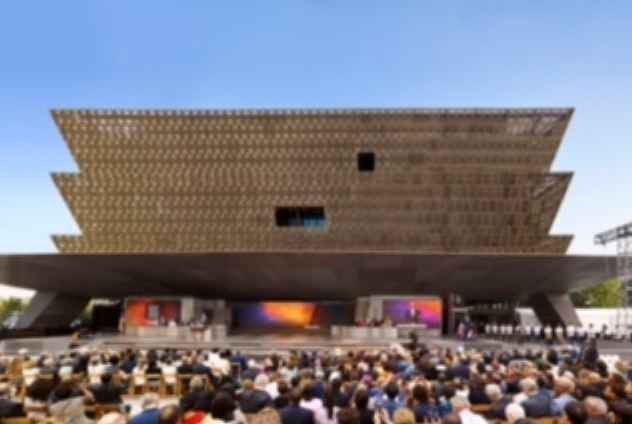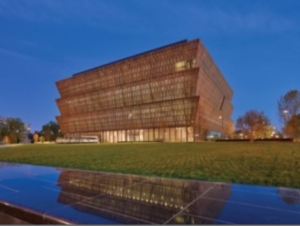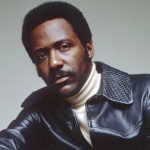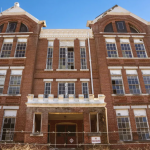
By Ahnayah Hughes, Howard University News Service
WASHINGTON — Most anyone who was there will tell you it was a remarkable weekend they will never forget.
First, there was the celebratory concert featuring artists Mary J. Blige, Jamie Foxx, Usher, Common, Ne-Yo, Christina Aguilera, Gladys Knight, Shirley Caesar, Chloe x Halle, Fantasia, John Legend, Mary Mary, Donnie McClurkin, Robert Glasper, John Batiste, Herbie Hancock and Cynthia Erivo,
The next day was the grand opening.
Three dramatically different American presidents– Bill Clinton, George W. Bush and Barack Obama – gathered for the affair.
Leading government officials and entertainment, business, cultural and civil rights icons — from U.S. Supreme Court Chief Justice John Roberts to actors Angela Basset and Robert DeNiro to former American Express chair and CEO Ken Chenault and Johnson Publishing Company owner Linda Johnson Rice to U. S. Rep. John Lewis — took the stage while scores of other celebrities were sprinkled throughout the audience.
Actor Will Smith and entertainment mogul Oprah Winfrey read the poetry of Langston Hughes and Maya Angelou, and artists Stevie Wonder and Patti Labelle performed before Obama gave the keynote speech.

And then, led by the president and the first lady, hundreds took the first official steps into the National African American Museum of History and Culture.
On that day, Sept. 24, 2016, the museum opened its doors as the largest institution dedicated to exploring, educating and celebrating African-American life and its global impact in history.
This year the museum celebrates its fifth anniversary. It is one of the most popular sites on the National Mall, according to the Smithsonian’s 2020 visitor statistics,, even more popular than the National Museum of American History, the National Zoo and the National Air and Space Museum.
Between the museum’s opening in September 2016, to March 2020 the museum has received over 7.4 million visitors from across the globe, officials reported.
The curator of American slavery at the museum, Mary Elliot, said that the success of the museum speaks to its relevance and necessity.
“If you don’t know the history, then you can’t understand where we are today,” Elliot said. “And you don’t know how to make change, or why to make change.
“This is not a segregated history. This is everyone’s history. This is an American story, seen through the African-American lens.”

The site has become hub for learning and preserving African American history thanks to the thousands of Black donors across the nation who contributed to its collections and fundings, including high-dollar donors like the Oprah Winfrey Charitable Foundation, who donated over $21 million dollars.
African Americans represented 74% of the individuals who gave $1 million or more, including Alfred Street Baptist Church Alexandria, Virginia, whose $1 million donation, the pastor said, included individual donations as large as $20,000 and as small as 50 cents.
Among those donors is the Jack and Jill of America Inc., an organization of Black women founded in 1938 that teaches leadership development, cultural heritage and community service to the children of the mother who are members in its 252 chapters nationwide.
In an email, the organization said it is thankful the museum gave it a place to document its work with African American children and families.
“Five years later, we are thankful that our donation is still available for visitors to view and learn about our organization,” a spokesperson wrote. “We are even more thankful to be among so many contributions sharing the collective African American story and that museum has continued to thrive.”
Today, the museum serves thousands of people daily, while also hosting numerous school tours of all grade levels, senior visits and international guests. It also hosts lectures, movie screenings, book signings and workshops.

The museum has about 3,000 objects on display from its collection of more than 37,000, including a 1922 Jim Crow railroad passenger car, a 1944 open-cockpit airplane used to prepare Tuskegee Airmen for World War II combat duty and artworks by Black artists Charles Alston, John Biggers, Elizabeth Catlett, Jacob Lawrence, Lorna Simpson, Romare Bearden, Archibald John Motley Jr., Henry O. Tanner and Frederick C. Flemister, Kehinde Wiley and Amy Sherald.
Tanish Glover, who was visiting the museum with her family, said the museum felt like a special space especially for them.
“I came here to see a museum that was for us and about us,” said Glover, a as she toured the museum’s Community Galleries, a third-floor exhibit dedicated to sports, activism, military service and achievement in various careers.
“Most times in museums, I’ll just glance and move on to the next thing.” she said, “but here, I’m really taking the time to read everything and take it all in.”
Elliott said that typical dwelling time in the average museum is one and a half to two and a half hours.
“People stay in our museum for six hours,” she said. “Most museums don’t have as much text, but I knew people would want to read and understand.”
Patrick Kelley, a self-professed history lover, traveled from Dallas, Texas, to visit the museum with his wife. He said he carefully looked over each label, because he wanted to really digest the material.

“It’s a bit overwhelming, because there’s so much to look at, and I want to see it all,” Kelley said.
“Coming here, I found out that there was a lot I knew, and a lot I didn’t know,” he said.
The museum serves as a learning center even for Dyane Amos and Jackie Henry, who work as volunteer guides officially called docents in the museum’s Freedom and Slavery Exhibition.
“When this opportunity came, I was excited and nervous, because there’s so much responsibility translating the mission of the museum,” Amos said, “but I feel beyond honored to do it.”
The two said they have worked together at the museum since it opened but have not been doing tours since the pandemic began in March of 2020.
“I hope we can resume the tours next year,” Henry said. “It has been so rewarding, fulfilling and mind expanding.”
For Amos, the museum is especially personal. She said the 1853 slave cabin from Edisto Island, South Carolina, displayed in the museum was exactly as the one her grandmother described.

“This is a living museum with living history,” she said. “This one breathes.”
Jacqui Rivera, who traveled from Florida to visit, said she was near tears in the museum’s History Galleries, which takes visitors up from three levels underground takes viewers from the brutal history of slavery through African American life to the present.
“I knew once I started crying, I would have wanted to leave and not see anything else,” she said. “So instead, I just felt it in my heart.”
“The beginning was hard to walk through, but when you come up you feel lighter walking through.”
By then, Rivera had passed through the painful past and was standing among the famous “Mothership” spaceship used by the band Parliament Funkadelic, rock and roll pioneer Chuck Berry’s ruby-red 1973 convertible Cadillac Eldorado and hundreds of other music artifacts on the museum’s fourth level dedicated to arts and culture.
Courtney Spencer visited the museum with her husband, Michael, and their two daughters. She said she also found it difficult starting at the museum’s lower levels.
“It was emotional at the bottom, but as you made your way towards the top, you saw the progress,” Spencer said. “It felt better,”
Elliott said it was important in curating the museum to emphasize the idea of pride in Black people surviving.
“It’s important to take pride in our history and not lean into the narrative that we are just victims,” she said. “We were, and it was a horrible, terrible thing. But we have to take ownership of our strength as well.”
Help us Continue to tell OUR Story and join the AFRO family as a member – subscribers are now members! Join here!
The post Looking back and forward: A remembrance for the National African American Museum of History and Culture appeared first on AFRO American Newspapers .










